The Many
Sauropods of the Mighty Morrison
from the Dinosaur Collector
Page 4 updated 08/1/06
Late Jurassic Diorama pages................ More Diorama and pages
There was more diversity among the sauropods of North America than is usually appreciated. While Diplodocus and Apatosaurus are the best known diplodocids there were also a number of less common relatives some of them becoming very large like Barosaurus, Seismosaurus and Supersaurus. This family is characterized by weak pencil like teeth , had long necks great size, fore limbs that are shorter in front than the back and necks that seem designed to lift only at limited angles. Several ideas have been put forth to explain these characteristics. A popular idea is that diplodocids were are able rear up on their back legs balanced with their tails. The other is that they specialized in mid level to low feeding using their necks like booms to feed over large areas. Normally when you have a variety of closely related animals living in the same area it is a sign that each has developed a slightly different feeding strategy. Exactly how they differed is hard to imagine.
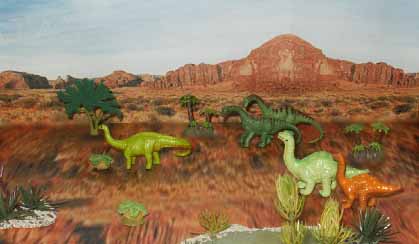
This a selection from Safari Mini and Toob lines. Center left is the ANHM Apatosaurus then a Carnegie Mini Apatosaurus and Diplodocus paired with Dino Toob counter parts. Thanks to AllDinos.com for donating a prototype Play Set Diorama box. Plants and playa created by Fred Hinojosa.
While most speculation is about Diplodocus and its kin rearing up to feed, fight or mate the Jurassic Park movie had a rearing Brachiosaurus. This seems an unlikely feeding posture but it is a plausible stance for a breeding male. Brachiosaurids differed in other ways have fore limbs longer than the hind and robust teeth. A less common but a wide spread family.
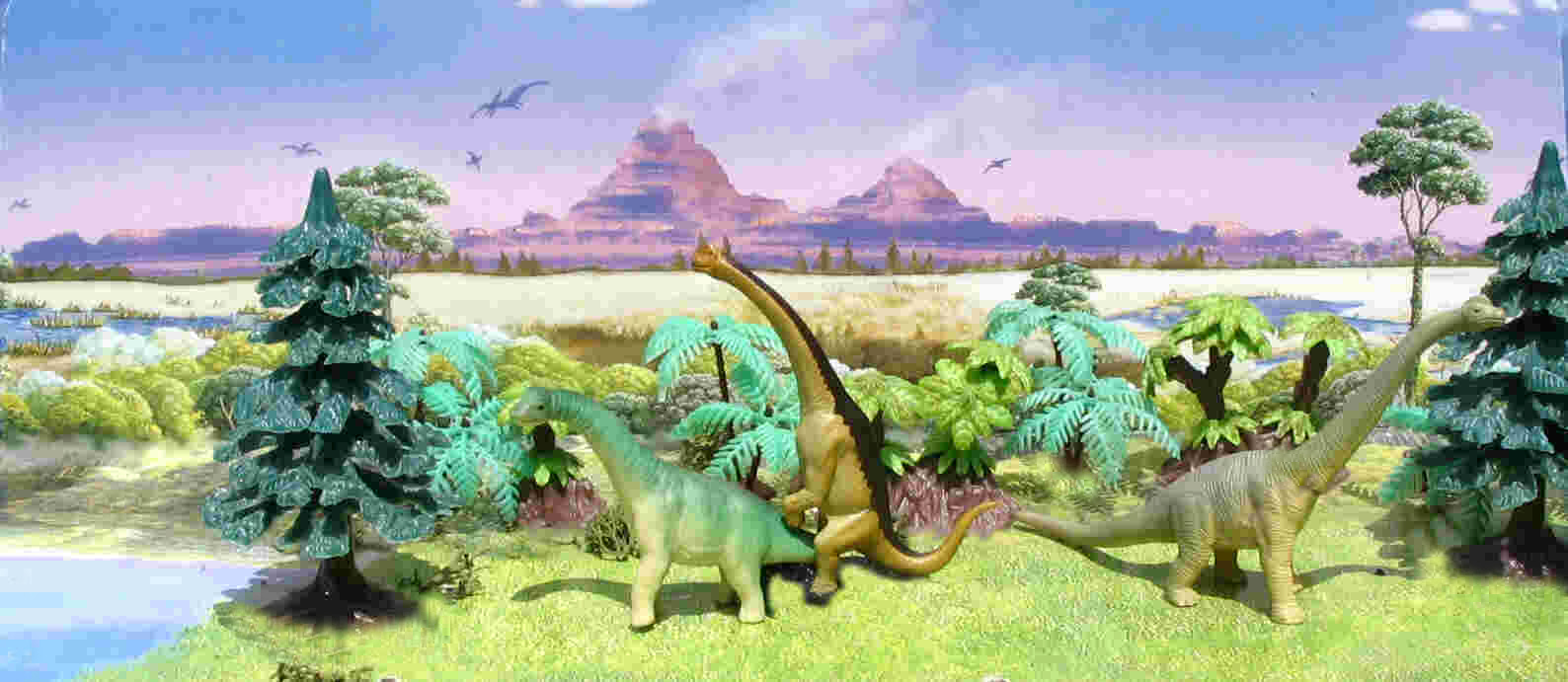
Bullyland Micro Tier Brachiosaurus, a rearing JP Brachiosaurus from the Japanese Pepsi premiums and a National Geographic Micro machine Brachiosaurus.
The medium sized Camarasaurus was wide spread and seems to have included both a large and a dwarf variety. They came in at least two sizes large and bigger. Animals remarkably like Camarasaurus are still found in Cretaceous of Africa validating their design. They seem to reflect a good generalized design.
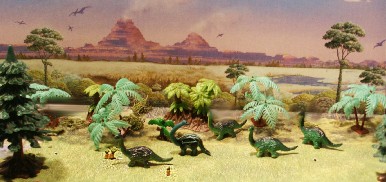
UKRD Brontosaurus/Camarasaurus and Action Products Apatosaurus
Why did the sauropods of the Late Jurassic get so big? Size has several advantages and disadvantages. An adult animal probably had no natural enemies. Large animals are usually not picky eaters and are better at living on plants with low food value. They also are better able to travel long distances to feed in arid environments. The largest Elephants today can be found in the deserts of the Namibia. There are also disadvantages, they need big ranges and because they have smaller breeding populations than smaller animals they suffer extinction at higher rates. Range doesn't seem to have a problem in the Jurassic. The continents were still connected and there is some evidence of Barosaurus and Brachiosaurus having ranges from the Western North America to East Africa. Sauropods may have reached reproductive maturity well before growing to full size as some lizards today. Where larger mammals typical have one 1 or 2 off spring every couple of years sauropods could produce a dozen or more eggs every years so even after a population crash just a few adults could restore the population much more quickly than a similar volume of elephants or rhinos today.
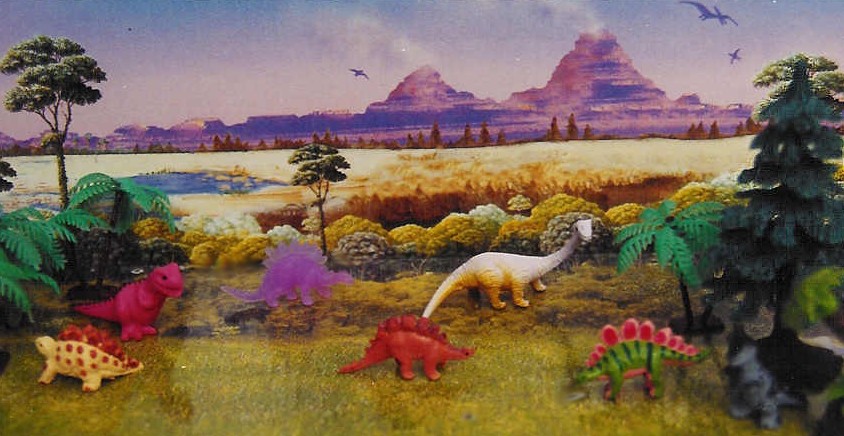
The Yellow K&M Stegosaurus, a pink Schleich theropod ( it has more than 2 fingers so it shouldn't be a Tyrannosaurus) a purple Tim Mee style Stegosaurus, an orange UKRD mini Stegosaurus, a green Action Products Stegosaurus and blue K&M theropod. A best guess is that both therapods should be Allosaurus. The white sauropod is from an Equity "Polly Pocket" style play set. It is made of a material similar to that used for Starlux figures.
Brachiosaurus were the giraffes of the Morrison. Feeding high among the conifers. Although the giraffe can reach food sources beyond the range of most other animals the majority of its feeding is done lower, the advantage is that in times of scarcity they have an additional food source. Brachiosaurus may also have spent a high amount of their time feeding lower down. A difference between the brachiosaurs and the diplodocids is that the brachiosaurs had very robust teeth indicating a different diet perhaps one contained more fiber. They were most likely capable of giving a nasty bite to predators. Diplodocids had weak pencil like teeth that were probably only useful as rakes to bring food in so it could be digested and broken down in their giant guts using gastrolithes.
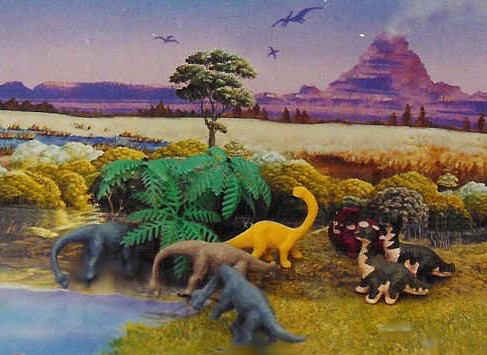
The brachiosaurs are from a Mexican premium set based on Disney's Dinosaur, the represent the Baylene character. The Yellow Apatosaurus is a mini version of the 70's Tim Mee figure. The remaining Brachiosaurus and Apatosaurus and K&M mini figures. All show surprising detail for figures that are coin sized
Giant sauropods like the diplodocid Seismosaurus found in New Mexico may just represent old individuals of more common types. Although recent finds show that many previous fossils though to represent adolescents are actually dwarf adults makes it more likely we are dealing with separate giant species. Seismosaurus (Earth Shaking lizard) may prove to be the longest dinosaur know at 150 feet. Legs haven't been found so it has been suggested that Seismosaurus could be a long but relatively short legged dachshund like sauropod.

Kaiyodo UHA Seismosaurus and a pair of mini UKRD Camarasaurus.
Piles of stones were found associated with the Seismosaurus fossil and these were interpreted as gastrolithes used help digest food. It was even suggested that one particularly large stone was the cause of the animals death, having caused it to choke.
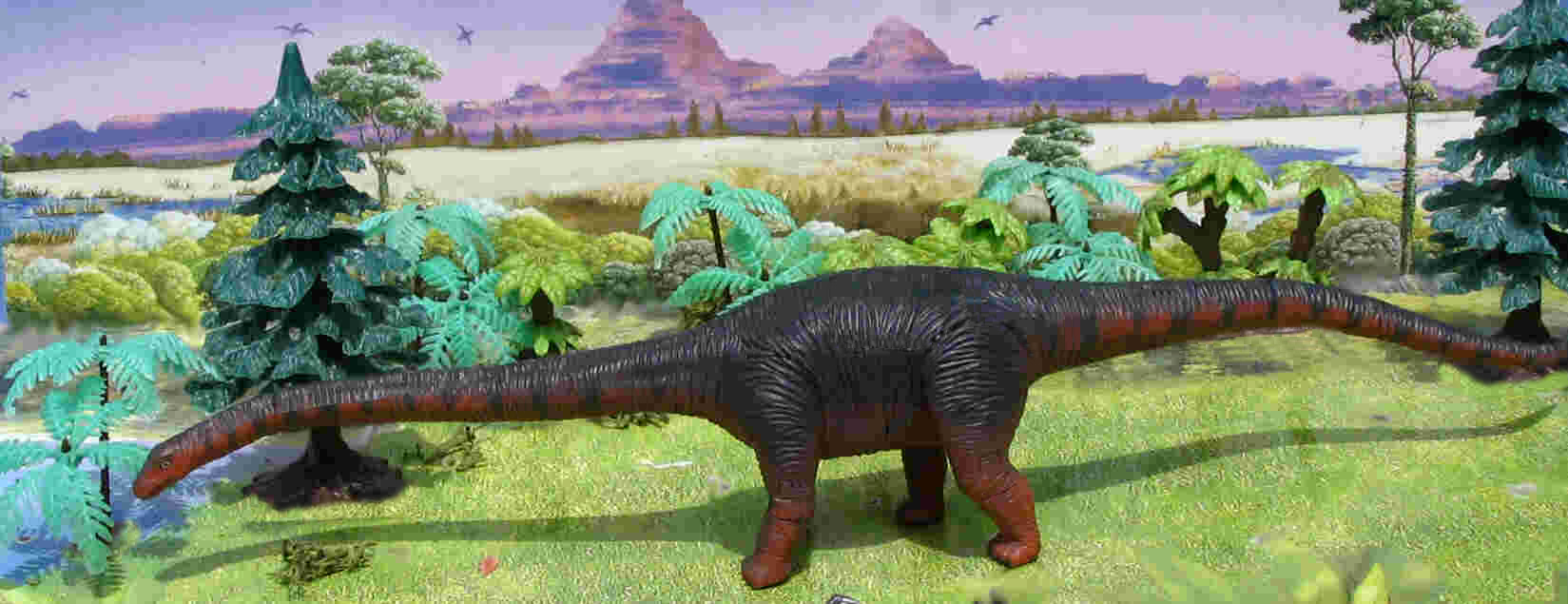
FameMaster 4D puzzle Seismosaurus
Brachiosaurus seems to be the tallest of of the sauropods and it doesn't appear to have the diversity of the diplodocids which could be a sign we are dealing with a less specialized animal. It had robust teeth like its relative Camarasaurus and an advantage for tree top browsing. The Jurassic Brachiosaurus also had toe claw that was lost by the time of the Cretaceous.
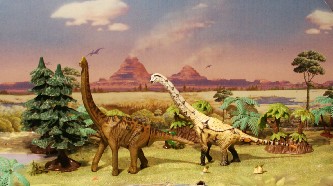
Furuta and UHA Brachiosaurus
The Ultrasaurus or Ultrasauros found in the Utah quarry now seems most likely to have been a large (but not the largest) Brachiosaurus mixed with some Supersaurus bones. The name Ultrasaurus was use for a relatively unremarkable Korean sauropod before being formally described. So Ultrasaurus is technically for another fossil find and even if it wasn't it is a junior synonym for Supersaurus.
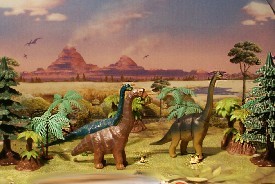
K&M Wild Republic, Disney and mini series FameMaster 4D Brachiosaurus.
Interestingly descendants of Brachiosaurus survived the in North America after the diplodocids disappear in the Early Cretaceous and do seem to radiate into a greater variety of species. The giant titanosaurs of the Late Cretaceous are thought to be close relatives.
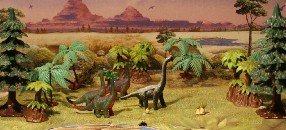
UKRD mini Brachiosaurus and JP Brachiosaurus
Back to the Mesozoic
| Previous Page 3 | More Pages from the Morrison |
Next Page 5 |
Site A icon for Dioramas organized by period or by manufacturer.